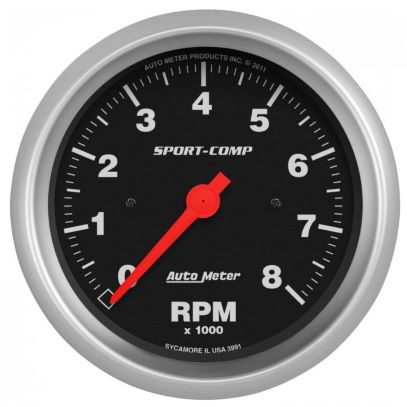Tachometer Basics: Whatever You Required to Know for Accurate Readings
Tachometer Basics: Whatever You Required to Know for Accurate Readings
Blog Article
The Significance of a Tachometer in Checking Engine Speed and Performance in Automotive Applications
In the world of automotive engineering, the tachometer stands as a crucial instrument in the chauffeur's collection, offering a straight home window into the internal functions of a lorry's engine. Past its function as a simple scale of changes per minute (RPM), the tachometer offers as a critical tool for enthusiasts and specialists alike, using real-time understandings right into engine efficiency and wellness.
Value of Monitoring Engine RPM
Keeping track of engine RPM, or transformations per min, is a crucial aspect of automotive upkeep and performance evaluation. Engine RPM directly correlates with the speed at which the engine's crankshaft turns, showing just how promptly the engine is running - tachometer. By keeping an eye on RPM, auto mechanics can analyze the wellness of the engine, detect prospective problems, and fine-tune efficiency. An unusual RPM analysis may indicate troubles such as engine misfires, defective ignition system, or concerns with the gas shipment system. Constantly high RPM analyses might show hostile driving habits or the demand for a greater equipment change to enhance fuel efficiency.
Additionally, checking engine RPM is vital for performance assessment in auto racing and high-performance automobiles. In summary, checking engine RPM is not only vital for finding issues however additionally for enhancing engine efficiency in various vehicle applications.

Benefits of Real-Time Information
In vehicle applications, real-time data plays an essential function in supplying instantaneous insights into the performance and condition of the vehicle. By continuously keeping an eye on different criteria such as engine rate, temperature level, fuel consumption, and a lot more, real-time information supplies many advantages that add to improved effectiveness and security when driving.
One significant benefit of real-time data is its ability to sharp vehicle drivers and professionals to any kind of abnormalities or problems immediately. This positive strategy allows quick recognition of potential problems, permitting prompt interventions to avoid additional damage or malfunctions. Furthermore, real-time data assists in performance optimization by offering prompt responses on driving practices and engine efficiency. Chauffeurs can adjust their habits in real-time based on this details to achieve better fuel economic climate and prolong the lifespan of their automobile.

Moreover, real-time information plays a vital duty in contemporary vehicle diagnostics, allowing professionals to quickly diagnose and resolve breakdowns. This results in reduced downtime, lower upkeep prices, and inevitably, boosted general automobile dependability and long life (tachometer). By harnessing the power of real-time information, vehicle stakeholders can make educated decisions that positively influence both the efficiency and long life of the automobile
Influence On Gear Shifts
The tachometer plays an important role in maximizing equipment shifts by offering real-time engine speed data to the motorist. When coming close to the redline on the tachometer, it signals the motorist to upshift to prevent over-revving the engine and creating potential damage.
Furthermore, the tachometer aids in attaining smoother gear transitions, especially in manual transmissions. By monitoring engine rate, motorists can execute equipment changes at the ideal RPM array, lowering jerking motions and reducing wear on the transmission elements. This accuracy on duty changes not just improves driving comfort yet also adds to sustain effectiveness.
Enhancing Gas Efficiency
Provided the crucial duty the tachometer plays in optimizing gear shifts for efficiency and engine wellness, it straight adds to maximizing gas efficiency in automobile applications. By offering real-time comments on engine rate, the tachometer aids drivers in keeping the most efficient RPM array for fuel economy. When motorists constantly keep track of find more info the tachometer and change their motoring routines as necessary, they can stay clear of unneeded fuel intake brought on by over-revving or carrying the engine.
Additionally, the tachometer helps drivers determine the most fuel-efficient equipment to be in at any kind of provided minute, avoiding the engine from functioning more difficult than essential. This is particularly crucial throughout acceleration and travelling, where being in the appropriate equipment can significantly influence fuel effectiveness. Furthermore, the tachometer can signal motorists to prospective mechanical issues that might be negatively impacting gas economic climate, such as a slipping clutch or a stopped up air filter. click over here now To conclude, the tachometer functions as an important tool in enhancing fuel performance by promoting optimal driving habits and recognizing locations for renovation in the lorry's performance.

Maximizing Engine Durability
The tachometer's function in keeping an eye on engine speed and efficiency is important in making sure the long life of vehicle engines. Keeping an eye on the tachometer permits motorists to remain within the suggested RPM variety for their car, preventing unneeded strain on the engine and extending its life-span.

Conclusion
Finally, the tachometer plays an essential function in keeping track of engine rate and performance in automotive Full Report applications. By offering real-time information on RPM, it enables efficient equipment shifts, boosted gas efficiency, and made best use of engine long life. This device is vital for preserving optimal engine efficiency and ensuring the total performance of a vehicle.
Report this page